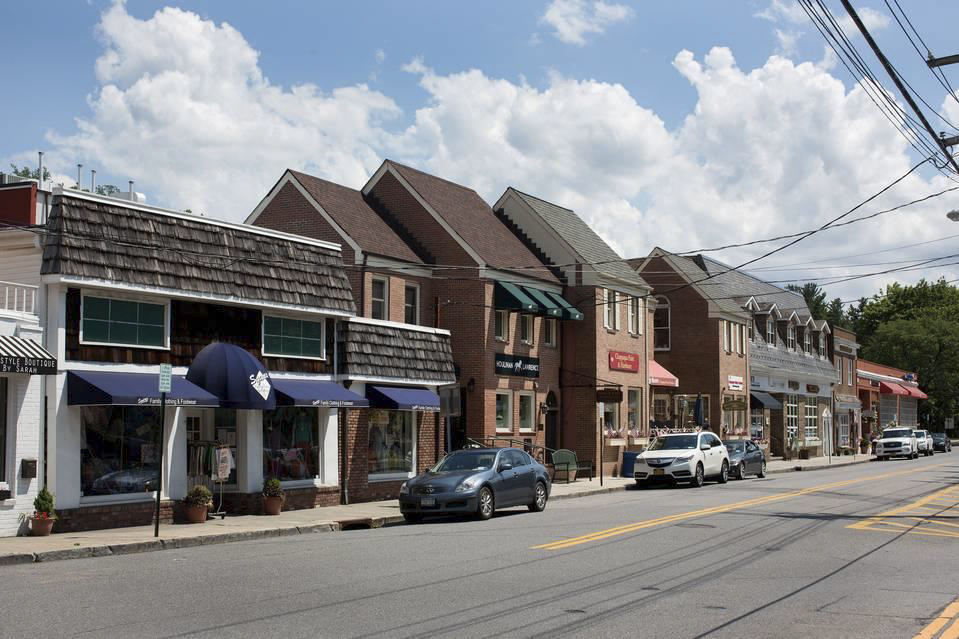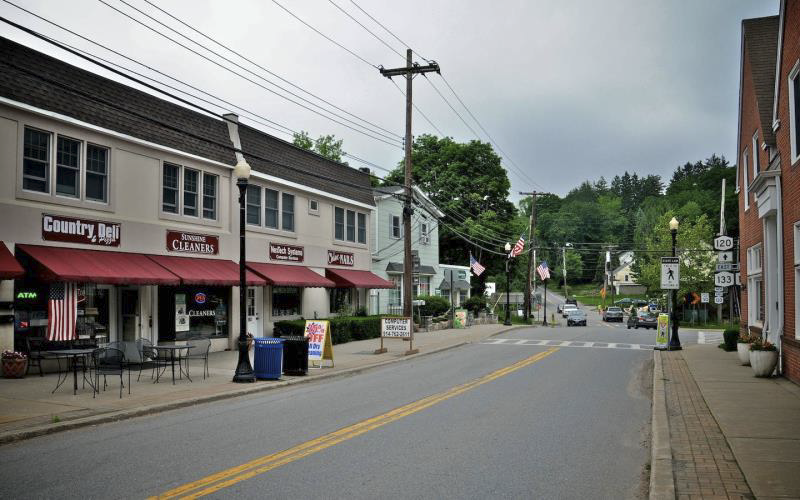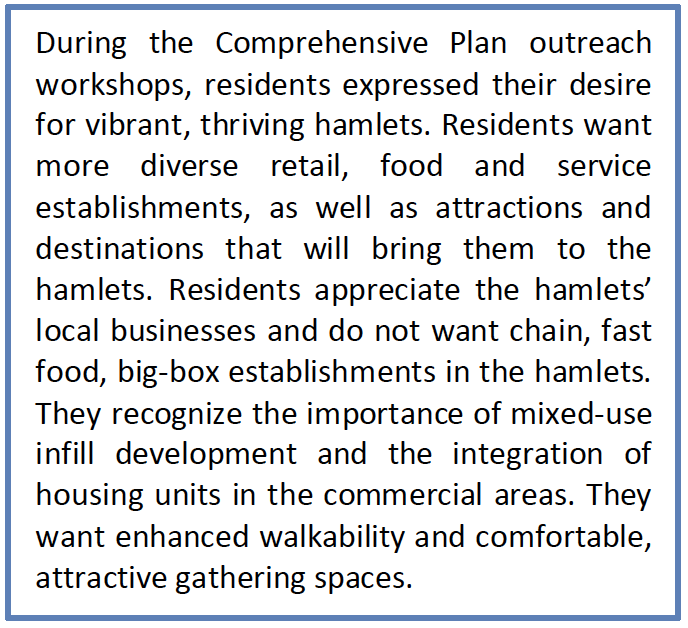New Castle Hamlets
Resilient Economy:
New Castle Hamlets

The majority of economic activity in New Castle takes place in the Town’s hamlets, Chappaqua and Millwood. At the writing of the TDP, it was well-known and accepted that the Town’s residents patronized the commercial areas of surrounding municipalities, both because of convenience and to supplement the goods and services offered within the Town’s hamlets. For this reason, the TDP did not encourage additional commercial development in the hamlets or an expansion of hamlet boundaries. The TDP also recommended against further commercial development in the hamlets because it would create unmanageable parking demand in the Chappaqua hamlet and have the potential to conflict with the residential feel of the rest of the Town. This policy has helped to shape the Chappaqua and Millwood hamlets as we know them today.
Chappaqua and Millwood have served as hubs of community and commercial activity for decades. Longtime community businesses such as the Chappaqua Village Market, Lange’s, Family Britches, Susan Lawrence, Petticoat Lane, Drug Mart and Rocky’s serve loyal customer bases. The Bagel Emporium, Chappaqua Station, and Tazza Café burst with activity during morning rush hours. Residents gather to participate in community movie nights and concerts, sporting competitions, camps and fundraising events held at the Rec Field and Millwood Park during the spring, summer and fall months. Annual sidewalk sales and farmer’s markets provide time for community members to come together, get to know local merchants and support local businesses. During warm weather seasons, outdoor seating at Le Jardin Du Roi and Susan Lawrence quickly fill to capacity at meal times; the North County Trailway bustles with cyclists and joggers; and children can be seen playing on the Bell School and Gedney Park playgrounds and in Millwood Park.

While there is much that residents cherish about the hamlets, there are many ways in which Chappaqua and Millwood would benefit from economic revitalization efforts. Overall economic performance of the Town’s businesses is difficult to assess because the Town does not have access to the financial information of private business owners. However, focus group discussions with the business community suggest that a limited customer base has made it challenging for businesses to achieve their profit goals. Additionally, recent economic studies have indicated that retail capture rates for both hamlets are low, and for most types of retail there is an “outflow” of Town residents’ consumer spending to the commercial areas of other municipalities “Outflow” to internet shopping is also a considerable factor which is growing at a rapid pace.

Policies found within the TDP were supportive of this kind of pattern. Today, however, this policy has become an obstacle to the economic vitality of the Town’s hamlets. Furthermore, the advent of the Internet and the convenience of online shopping have revolutionized the consumer industry. To make any sort of retail purchase in 1989, one would almost definitely need to leave the house. Today, online mega-vendors like Amazon, Peapod and Zappos make it easy to purchase all types of goods, including perishables, with direct delivery, eliminating the need to patronize businesses in person. E‑commerce has contributed greatly to the “outflow” of resident spending, and has helped to transform the American “downtown”. New strategies need to be adopted in order for local businesses to remain relevant and successful in this new market.
It is within this context that this Plan establishes goals to help support local business and create thriving, 21st century hamlets. A community with a Resilient Economy has strong, dependable local assets, which includes healthy local businesses. In Chappaqua and Millwood, commercial, civic and community activity are co-dependent. This Plan establishes policies that will help ensure the hamlets’ built environment and land use regulations encourage a vibrant civic, cultural and community atmosphere that works in symbiosis with local economic activity.

This Plan establishes the goal to create a sustainable mix of residential and commercial uses within the hamlets, or mixed-use infill development. Such development will help satisfy the community’s varied housing needs while also helping to stimulate economic activity. Carefully planned mixed-use development in the hamlets including provisions to address parking supply will allow for further integration of residential and commercial uses, providing business establishments with a consistent, built-in consumer base that does not require the use of a vehicle to do their shopping. In order to support a substantial residential population in the hamlets, businesses should be tailored to serve the needs of and provide for those populations. In addition, there must be other retail, entertainment and civic opportunities and destinations within the Town to attract populations from outside the hamlets. This Plan sets forth actions to explore opportunities to diversify the retail, entertainment, and civic destination mix in Chappaqua and Millwood, as well as to stimulate patronage and activity. As identified in the public outreach sessions parking supply is of paramount concern in the Chappaqua hamlet. Parking should be located in proximity to businesses and other amenities to accommodate patrons who drive downtown and are a vital part of the customer base for local merchants.
This Plan also establishes policies to create vibrant and walkable mixed-use areas in the hamlets that are well connected to public transit. Pedestrian-friendly circulation networks within hamlets that connect business establishments, housing, institutions, green spaces and public meeting places help to create an atmosphere where patrons are able and likely to gather. As of early 2017, sidewalks line Greeley Avenue and King Street in Chappaqua, but they are undersized and in disrepair. Chappaqua also would benefit from an increased number of crosswalks to make it easier for pedestrians to navigate the hamlet. Millwood’s commercial clusters are disjointed and the Millwood Shopping Center is setback from Station Road, making its parking lot the centerpiece of the hamlet. While the Metro North Harlem Line runs through the Chappaqua hamlet and Millwood boasts prime access to the North County Trailway, both of the hamlets lack sufficient and welcoming pedestrian networks to connect these invaluable transportation amenities to the commercial centers of each hamlet and the rest of the community. Much more can be done to entice those coming off the train or using the bike path to patronize the business establishments of the Chappaqua and Millwood hamlets. Additionally, improving pedestrian amenities and sidewalk infrastructure along Chappaqua’s mid-King Street area and Station Place in Millwood would help to strengthen commercial and residential uses along these corridors and connect retail nodes within each of the hamlets.
This Plan also establishes the goal to enhance the aesthetic quality of the hamlets. Both the Millwood and Chappaqua hamlets lack a coordinated, attractive aesthetic. While design guidelines for the Millwood Hamlet were developed in 1993 and revised in 1999, design guidelines were never developed for Chappaqua. It is questionable as to whether Millwood’s design guidelines can achieve their underlying goals given the infrastructure limitations in the hamlet. This Plan recommends revising Millwood’s existing design guidelines and creating design guidelines for Chappaqua that are attainable, promote aesthetic continuity and incorporate sustainable planning concepts.